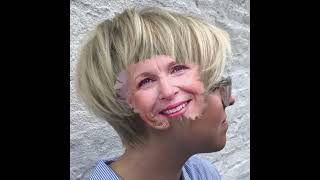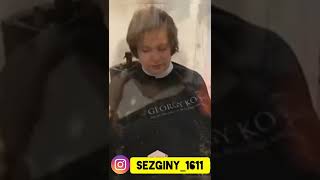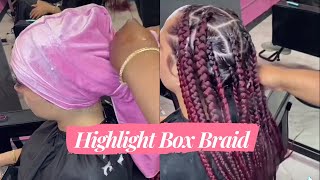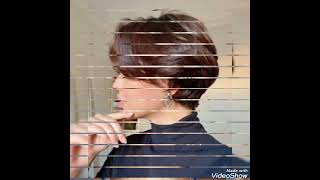Graduated Bob Haircut With Layers And Disconnection
- Posted on 28 February, 2022
- Bob Hairstyles
- By Anonymous
How to cut a Graduated Bob Haircut with Layers. This tutorial is an informative step by step how to cut a graduated bob with layers and disconnection.
You will learn how to apply multiple forms of graduation with disconnection to create a classic graduated bob shape combining layers to maximise texture and movement to this advanced graduated bob haircut shape with layers.
// WATCH NEXT : Basic Graduation Fundamentals
https://youtube.com/playlist?list=PLoK...
Welcome or welcome back to my channel in today's tutorial, we will be cutting a short classic graduated bob. The point of this tutorial is to showcase how we can utilize disconnection and incorporate different shapes and cutting techniques to create a personalized approach to a classic haircut. The previous haircut was a round solid one length shape. We start this haircut with mapping out our zones and sections. We will be creating this haircut with practical disconnection, meaning seamless or invisible disconnection. The opposite form of disconnection is called visual disconnection. That is where you can obviously see the short to long in the nape. We take a slight diagonal forward section. Approximately one and a half inches from the hairline. This zone will be cut with round graduation. The crown zone will be disconnected from the nape and cut with vertical triangular graduation with square distribution. The side zones will connect and blend into the top and crown zones working with a subtle graduation. The top crown zone will connect into the lower crowns graduation with increased layers. The fringe zone will connect and be over directed into the top crown zone to maintain length. The sectioning for round graduation in the nape is diagonal back sections working towards the center from both sides. Once we reach the center, we work from the opposite side until we cross over where our guides should meet for perfect symmetry. We start the haircut by taking a fine diagonal back section, our cutting line mirrors our section. We cut a fingers width in length. We continue to take diagonal back sections directing section two to section one. We direct the hair straight out from the head. Our cutting angle mirrors our section. We continue this process moving our body position with every new section, as we work towards the center of the nape section. 2 becomes our guide for section 3. Then section 3 becomes our guide for section 4. Our elevation is directed 90 degrees straight out from the base of each section, and our cutting angle continues to mirror our sections. We continue this process until we reach the center of the nape round. Graduation creates a soft, gradual build-up of weight without corners that complements your client's head shape. We now repeat the same process on the opposite side, working back towards the center of the nape. You will notice how round graduation complements your client's head shape, creating a fluid head. Hugging shape, i have chosen round graduation in the nape area to showcase something different from the standard, triangular or square graduation, and to open your mind to disconnecting different forms or graduations to create a personalized haircut. Once we meet the center of the nape, you will notice our guides from the opposite side connecting our new sections into our previous guides. This process will give us perfect symmetry of how the weight and length is built over the curvature of the occipital bone area. Creating perfect round graduation incorporating different shapes into one haircut will create an advanced, unique shape or feel for your clients. It may be that small difference that keeps your clients coming back for more. We now flat wrap this section into natural fall, preparing the nape zone for refining and scissor over comb. It'S important to assess the shape and look for any discrepancies. I am starting the refining process with point cutting into the hairline. This will help to collapse and soften the hairline. Before moving on to the scissor overcome process scissor over combing over your round, graduation is optional. I choose to softly, run my scissors over my round graduation to correct any unwanted discrepancies and to add more definition to the graduated shape. I feel a gently dusting of scissor over comb will make your graduation pop looking more polished and elevated. We cross check this zone with horizontal sectioning. This is round graduation. A soft subtle, head hugging shape. I personally love how this shape helps to elongate your client's neck. Even hydration and tension will help to maintain even precision in your haircuts. We start our next zone with a vertical section. This zone won't be connecting into the round graduation below. We need to assess the length before cutting our guide. The length of this section will determine the main length of our bob. We now direct our section straight out at 90 degrees and our cutting angle is vertically triangular. This will maintain length in the top of the section, whilst creating a textured graduated bob effect in the bottom of the section that falls over the nape zone in this zone. We are working with square distribution. Therefore, we have a traveling guide. Section 2 is directed to section 1, and section 3 is directed to section 2 working across this zone until we reach the curvature of the head, where we over direct the last sections back to this guide, to maintain or increase the length in our corners. We continue to direct our vertical sections straight out at 90 degrees and cutting with a triangular cutting angle, whilst maintaining our square distribution. It'S important to maintain consistent distribution, standing square to your section, directing each section to the center of your chest. In this position. You have great control of your side to side movements. This is triangular graduation with square distribution. This corner will give us options connecting through to the side sections, we repeat the same process. On the opposite side, i have chosen square distribution to create a wider shape horizontally. That builds corners gradually, whilst maintaining more weight and length in the back corners compared to triangular distribution. I have chosen triangular graduation vertically, as it gives me full control of the graduation from top to bottom of the section. Our cutting angle determines how heavy or soft our graduation will fall. If you struggle with graduation, you should check out my playlist basic graduation fundamentals. It covers in depth, step by step everything you need to know to understand and apply round square and triangular graduation. The link is in the description below we cross check square distribution by taking horizontal sections, you can now see practical disconnection with the lower crown area seamlessly falling over and blending into the nape zone. The square distribution builds corners that gives us options to maintain length into the side zones. We now move to the top zone. In this zone. We will be layering the hair to create volume and texture in our shape. We start with a center vertical profile section. We now direct the section 90 degrees straight back towards you. We use the longest length from the zone below as our guide and cut a square layer. We connect these two zones with the square corner in this layer. If we cut round the zones wouldn't connect and the top crown would be to shore a result, we never want the mistake of making. We now elevate our section 90 degrees off base and remove the corner cutting with round elevation, then increasing our cutting line. Moving up the section to maintain length in the top of the section working from square in the back into round and then into triangular elevation in one section square connects round, creates maximum volume in the crown, while increasing into triangular, maintains maximum length in our shape. Moving from the back to the top into the front of this zone, our distribution in this zone is on base working with the head, shape, repeat the same process on the opposite side being mindful of our distribution and elevation, i have chosen to layer this zone to Create maximum internal texture and movement, this haircut will have a versatile finish being able to be styled to look like a solid bob or a textured bob check your balance before moving into the side zones, we take our guides from the top and back zones our shape In the sides will be square, the length will slowly increase in length moving forward and our vertical shape will be triangle slightly shorter in the bottom to longer. In the top, we direct every new section back to the previous section, moving towards the front hairline, maintaining triangular elevation and square distribution. Once we complete this zone, we cross check with horizontal sections, ensuring we have cut a square shape horizontally. We repeat the same process on the opposite side. If you wanted a rapid increase in length moving forward, you could choose triangular distribution simply using our first guide. As a stationary guide, i chose to use square distribution, as the previous haircut was round, which meant i had no length in the front corners to work with it's really important to assess your options from the previous haircut before starting any haircut the round corners in the Front limited the length this haircut could have had we complete this zone with cross checking and also checking our balance with the opposite side. We now move on to the next zone. I take a guide from the previous zone to maintain maximum length. We over direct this zone to a stationary guide. Our distribution is triangular and our cutting angle is square. This zone is disconnected from the side zones, creating more movement in our shape, whilst increasing maximum length moving forward. We continue this process until we run out of length. We now move on to the fringe zone. I have decided to cut a side sweepy fringe. I am using the shortest length from the previous side zone. As my guide, i take small clean sections standing to the side directing every new section to my stationary guide that elevates higher and higher with every new section increasing length, as we continue to elevate and over direct every new section to our guide when cutting side, sweepy Fringes i cut the shortest side on the side. The fringe will be styled too. The gap that is created will help the fringe to sit in place also with the weight of the fringe's length on the opposite side. The end result when cut and styled this way is a bolder, stronger, looking fringe. It also helps your client to style, using the weight of the fringe to stay in place. Some people prefer to style the opposite way. With the shortest length exposed falling into the length. I think we should educate our clients with both options, as they may feel more comfortable styling one way over the other. Do you have a preference? Let me know in the comments we now wrap dry, the haircut into natural fall, preparing the haircut for the refining and personalizing process. Before we start the refining process, it's important to assess the haircut and see what options we have do we want to maintain weight. Do we want to maximize texture? I have decided to do a combination of both. I have decided to maintain strong square lines in the side sections whilst point cutting and adding texture to our layered zones, increasing the versatility of this haircut in the side zones. I use a point. Cutting method chipping away at any unwanted graduation, neck, trimmers or clippers can be an amazing tool to assist in refining a perfect line with hair textures that have a tendency to curl or bounce repeat the same process on both sides. Maintaining even balance before. Moving on to the fringe zone, if you don't have any anti-kink clips, you can simply use a fine piece of cardboard. We add the corner from the top fringe area and simply join this section into our side zone. This will allow our client to wear their fringe on either side with no disconnection. Here, you can see how the side, sweepy fringe, looks styled towards the shorter side. We now remove excess bulk and enhance texture by taking horizontal sections with deep point. Cutting my intention for this tutorial was to help you to understand that haircuts can be more than just one shape or one cutting method. Haircuts can be a combination of elevations and distributions and cutting angles when you learn how to fully utilize our tools by combining different shapes vertically and horizontally. Your hair cutting will advance very quickly if you learn something new or if you value this refresher, please hit the thumbs up, comment below or make my day and subscribe to my channel and a massive thank you for watching my tutorial. I do really appreciate your support. Here is the internal texture and movement in the shape, the disconnected graduations round in the nape and square in the crown and the side sweepy fringe. This is the the shape styled with no texture classic short graduated bob and styled with minimal texture. You





Comments
euphoricrecall: Masterfully done!
T Lannan: Awesome ✂️
Jamie Jamie: Can't wait to try this haircut. Thanks for sharing ☺️
Free Hair Education: Love this shape, so cool
Praphasri Sukhilak: Love it James ❤️❤️ thank you
Любаня Карнаухова: Hello,love your lessonsyehh strugle with forms,right:round,triangular,squared, thanks for mentioning.Please make a lesson about when do we use channel cutting? What kind of haircuts,form, show please....what trimmer do you use? Heavy?Bless You God,talented teacher
Live Life Nutrition Pty Ltd: Stunning
Timothy Lannan: Amazing work
ebattifora: You are the best of the best,thank you!!
Peanut Butter TV: This graduated bob haircut rocks
UN UNIQUE: ❤️❤️❤️